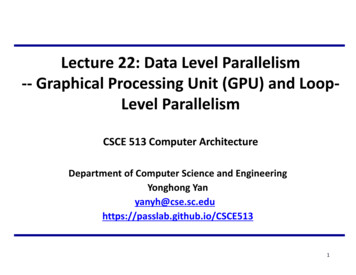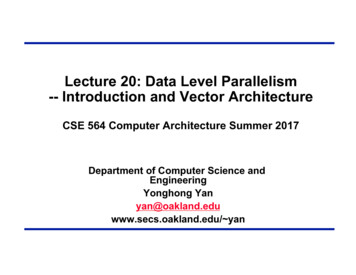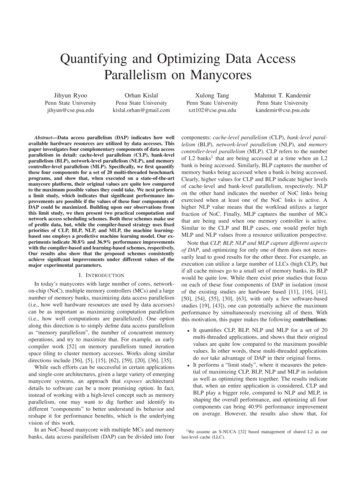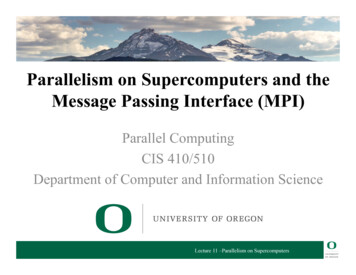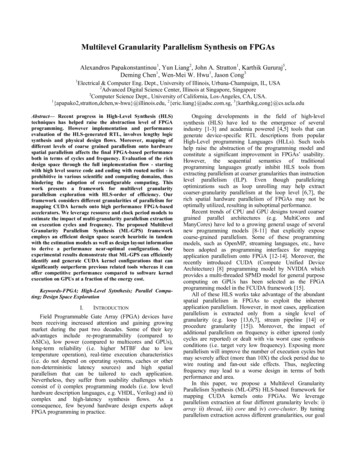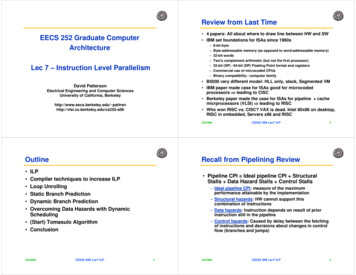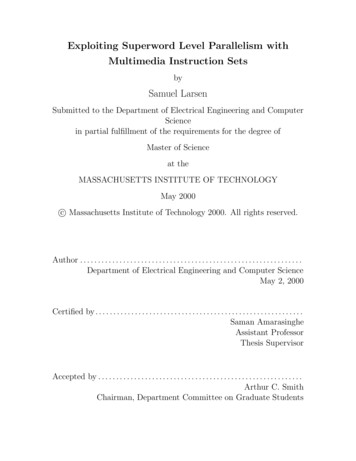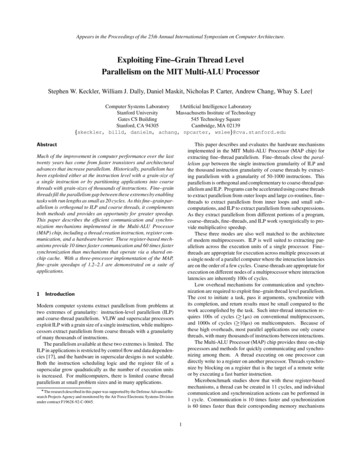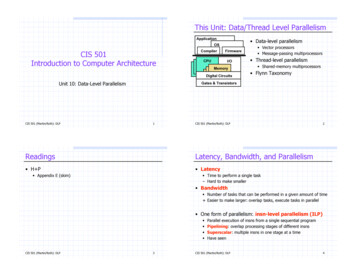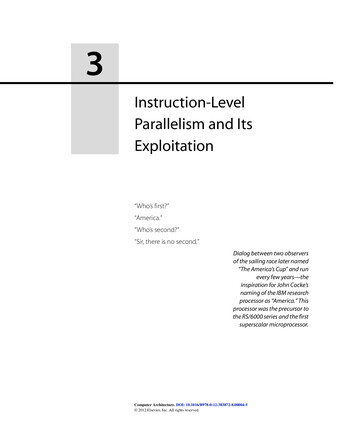
Transcription
3Instruction-LevelParallelism and ItsExploitation“Who’s first?”“America.”“Who’s second?”“Sir, there is no second.”Dialog between two observersof the sailing race later named“The America’s Cup” and runevery few years—theinspiration for John Cocke’snaming of the IBM researchprocessor as “America.” Thisprocessor was the precursor tothe RS/6000 series and the firstsuperscalar microprocessor.Computer Architecture. DOI: 10.1016/B978-0-12-383872-8.00004-5 2012 Elsevier, Inc. All rights reserved.1
148 Chapter Three Instruction-Level Parallelism and Its Exploitation3.1Instruction-Level Parallelism: Concepts and ChallengesAll processors since about 1985 use pipelining to overlap the execution ofinstructions and improve performance. This potential overlap among instructionsis called instruction-level parallelism (ILP), since the instructions can be evaluated in parallel. In this chapter and Appendix H, we look at a wide range of techniques for extending the basic pipelining concepts by increasing the amount ofparallelism exploited among instructions.This chapter is at a considerably more advanced level than the material on basicpipelining in Appendix C. If you are not thoroughly familiar with the ideas inAppendix C, you should review that appendix before venturing into this chapter.We start this chapter by looking at the limitation imposed by data and controlhazards and then turn to the topic of increasing the ability of the compiler and theprocessor to exploit parallelism. These sections introduce a large number of concepts, which we build on throughout this chapter and the next. While some of themore basic material in this chapter could be understood without all of the ideas inthe first two sections, this basic material is important to later sections of thischapter.There are two largely separable approaches to exploiting ILP: (1) an approachthat relies on hardware to help discover and exploit the parallelism dynamically,and (2) an approach that relies on software technology to find parallelism statically at compile time. Processors using the dynamic, hardware-based approach,including the Intel Core series, dominate in the desktop and server markets. In thepersonal mobile device market, where energy efficiency is often the key objective,designers exploit lower levels of instruction-level parallelism. Thus, in 2011, mostprocessors for the PMD market use static approaches, as we will see in the ARMCortex-A8; however, future processors (e.g., the new ARM Cortex-A9) are usingdynamic approaches. Aggressive compiler-based approaches have been attemptednumerous times beginning in the 1980s and most recently in the Intel Itaniumseries. Despite enormous efforts, such approaches have not been successful outside of the narrow range of scientific applications.In the past few years, many of the techniques developed for one approachhave been exploited within a design relying primarily on the other. This chapterintroduces the basic concepts and both approaches. A discussion of the limitations on ILP approaches is included in this chapter, and it was such limitationsthat directly led to the movement to multicore. Understanding the limitationsremains important in balancing the use of ILP and thread-level parallelism.In this section, we discuss features of both programs and processors that limitthe amount of parallelism that can be exploited among instructions, as well as thecritical mapping between program structure and hardware structure, which is keyto understanding whether a program property will actually limit performance andunder what circumstances.The value of the CPI (cycles per instruction) for a pipelined processor is thesum of the base CPI and all contributions from stalls:Pipeline CPI Ideal pipeline CPI Structural stalls Data hazard stalls Control stalls
3.1Instruction-Level Parallelism: Concepts and Challenges 149TechniqueReducesSectionForwarding and bypassingPotential data hazard stallsC.2Delayed branches and simple branch schedulingControl hazard stallsC.2Basic compiler pipeline schedulingData hazard stallsC.2, 3.2Basic dynamic scheduling (scoreboarding)Data hazard stalls from true dependencesC.7Loop unrollingControl hazard stalls3.2Branch predictionControl stalls3.3Dynamic scheduling with renamingStalls from data hazards, output dependences, andantidependences3.4Hardware speculationData hazard and control hazard stalls3.6Dynamic memory disambiguationData hazard stalls with memory3.6Issuing multiple instructions per cycleIdeal CPI3.7, 3.8Compiler dependence analysis, softwarepipelining, trace schedulingIdeal CPI, data hazard stallsH.2, H.3Hardware support for compiler speculationIdeal CPI, data hazard stalls, branch hazard stallsH.4, H.5Figure 3.1 The major techniques examined in Appendix C, Chapter 3, and Appendix H are shown together withthe component of the CPI equation that the technique affects.The ideal pipeline CPI is a measure of the maximum performance attainable bythe implementation. By reducing each of the terms of the right-hand side, wedecrease the overall pipeline CPI or, alternatively, increase the IPC (instructionsper clock). The equation above allows us to characterize various techniques bywhat component of the overall CPI a technique reduces. Figure 3.1 shows thetechniques we examine in this chapter and in Appendix H, as well as the topicscovered in the introductory material in Appendix C. In this chapter, we will seethat the techniques we introduce to decrease the ideal pipeline CPI can increasethe importance of dealing with hazards.What Is Instruction-Level Parallelism?All the techniques in this chapter exploit parallelism among instructions. Theamount of parallelism available within a basic block—a straight-line codesequence with no branches in except to the entry and no branches out except at theexit—is quite small. For typical MIPS programs, the average dynamic branch frequency is often between 15% and 25%, meaning that between three and six instructions execute between a pair of branches. Since these instructions are likely todepend upon one another, the amount of overlap we can exploit within a basicblock is likely to be less than the average basic block size. To obtain substantialperformance enhancements, we must exploit ILP across multiple basic blocks.The simplest and most common way to increase the ILP is to exploit parallelism among iterations of a loop. This type of parallelism is often called loop-levelparallelism. Here is a simple example of a loop that adds two 1000-elementarrays and is completely parallel:
150 Chapter Three Instruction-Level Parallelism and Its Exploitationfor (i 0; i 999; i i 1)x[i] x[i] y[i];Every iteration of the loop can overlap with any other iteration, although withineach loop iteration there is little or no opportunity for overlap.We will examine a number of techniques for converting such loop-level parallelism into instruction-level parallelism. Basically, such techniques work byunrolling the loop either statically by the compiler (as in the next section) ordynamically by the hardware (as in Sections 3.5 and 3.6).An important alternative method for exploiting loop-level parallelism is theuse of SIMD in both vector processors and Graphics Processing Units (GPUs),both of which are covered in Chapter 4. A SIMD instruction exploits data-levelparallelism by operating on a small to moderate number of data items in parallel(typically two to eight). A vector instruction exploits data-level parallelism byoperating on many data items in parallel using both parallel execution units and adeep pipeline. For example, the above code sequence, which in simple formrequires seven instructions per iteration (two loads, an add, a store, two addressupdates, and a branch) for a total of 7000 instructions, might execute in one-quarter as many instructions in some SIMD architecture where four data items areprocessed per instruction. On some vector processors, this sequence might takeonly four instructions: two instructions to load the vectors x and y from memory,one instruction to add the two vectors, and an instruction to store back the resultvector. Of course, these instructions would be pipelined and have relatively longlatencies, but these latencies may be overlapped.Data Dependences and HazardsDetermining how one instruction depends on another is critical to determininghow much parallelism exists in a program and how that parallelism can beexploited. In particular, to exploit instruction-level parallelism we must determinewhich instructions can be executed in parallel. If two instructions are parallel, theycan execute simultaneously in a pipeline of arbitrary depth without causing anystalls, assuming the pipeline has sufficient resources (and hence no structural hazards exist). If two instructions are dependent, they are not parallel and must be executed in order, although they may often be partially overlapped. The key in bothcases is to determine whether an instruction is dependent on another instruction.Data DependencesThere are three different types of dependences: data dependences (also calledtrue data dependences), name dependences, and control dependences. An instruction j is data dependent on instruction i if either of the following holds: Instruction i produces a result that may be used by instruction j. Instruction j is data dependent on instruction k, and instruction k is datadependent on instruction i.
3.1Instruction-Level Parallelism: Concepts and Challenges 151The second condition simply states that one instruction is dependent on another ifthere exists a chain of dependences of the first type between the two instructions.This dependence chain can be as long as the entire program. Note that a dependence within a single instruction (such as ADDD R1,R1,R1) is not considered adependence.For example, consider the following MIPS code sequence that increments avector of values in memory (starting at 0(R1) and with the last element at 8(R2))by a scalar in register F2. (For simplicity, throughout this chapter, our examplesignore the effects of delayed 2F4,0(R1)R1,R1,#-8R1,R2,LOOP;F0 array element;add scalar in F2;store result;decrement pointer 8 bytes;branch R1! R2The data dependences in this code sequence involve both floating-point data:Loop:L.DF0,0(R1);F0 array elementADD.DF4,F0,F2;add scalar in F2S.DF4,0(R1);store resultand integer data:DADDIUR1,R1,#-8;decrement pointer;8 bytes (per DW)BNER1,R2,Loop ;branch R1! R2In both of the above dependent sequences, as shown by the arrows, each instruction depends on the previous one. The arrows here and in following examplesshow the order that must be preserved for correct execution. The arrow pointsfrom an instruction that must precede the instruction that the arrowhead points to.If two instructions are data dependent, they must execute in order and cannotexecute simultaneously or be completely overlapped. The dependence impliesthat there would be a chain of one or more data hazards between the twoinstructions. (See Appendix C for a brief description of data hazards, which wewill define precisely in a few pages.) Executing the instructions simultaneouslywill cause a processor with pipeline interlocks (and a pipeline depth longer thanthe distance between the instructions in cycles) to detect a hazard and stall,thereby reducing or eliminating the overlap. In a processor without interlocks thatrelies on compiler scheduling, the compiler cannot schedule dependent instructions in such a way that they completely overlap, since the program will not execute correctly. The presence of a data dependence in an instruction sequencereflects a data dependence in the source code from which the instruction sequencewas generated. The effect of the original data dependence must be preserved.
152 Chapter Three Instruction-Level Parallelism and Its ExploitationDependences are a property of programs. Whether a given dependenceresults in an actual hazard being detected and whether that hazard actually causesa stall are properties of the pipeline organization. This difference is critical tounderstanding how instruction-level parallelism can be exploited.A data dependence conveys three things: (1) the possibility of a hazard, (2) theorder in which results must be calculated, and (3) an upper bound on how muchparallelism can possibly be exploited. Such limits are explored in Section 3.10 andin Appendix H in more detail.Since a data dependence can limit the amount of instruction-level parallelismwe can exploit, a major focus of this chapter is overcoming these limitations.A dependence can be overcome in two different ways: (1) maintaining the dependence but avoiding a hazard, and (2) eliminating a dependence by transformingthe code. Scheduling the code is the primary method used to avoid a hazard without altering a dependence, and such scheduling can be done both by the compilerand by the hardware.A data value may flow between instructions either through registers orthrough memory locations. When the data flow occurs in a register, detecting thedependence is straightforward since the register names are fixed in the instructions, although it gets more complicated when branches intervene and correctness concerns force a compiler or hardware to be conservative.Dependences that flow through memory locations are more difficult to detect,since two addresses may refer to the same location but look different: For example, 100(R4) and 20(R6) may be identical memory addresses. In addition, theeffective address of a load or store may change from one execution of the instruction to another (so that 20(R4) and 20(R4) may be different), further complicating the detection of a dependence.In this chapter, we examine hardware for detecting data dependences thatinvolve memory locations, but we will see that these techniques also have limitations. The compiler techniques for detecting such dependences are critical inuncovering loop-level parallelism.Name DependencesThe second type of dependence is a name dependence. A name dependenceoccurs when two instructions use the same register or memory location, called aname, but there is no flow of data between the instructions associated with thatname. There are two types of name dependences between an instruction i thatprecedes instruction j in program order:1. An antidependence between instruction i and instruction j occurs wheninstruction j writes a register or memory location that instruction i reads. Theoriginal ordering must be preserved to ensure that i reads the correct value. Inthe example on page 151, there is an antidependence between S.D andDADDIU on register R1.2. An output dependence occurs when instruction i and instruction j write thesame register or memory location. The ordering between the instructions
3.1Instruction-Level Parallelism: Concepts and Challenges 153must be preserved to ensure that the value finally written corresponds toinstruction j.Both antidependences and output dependences are name dependences, asopposed to true data dependences, since there is no value being transmittedbetween the instructions. Because a name dependence is not a true dependence,instructions involved in a name dependence can execute simultaneously or bereordered, if the name (register number or memory location) used in the instructions is changed so the instructions do not conflict.This renaming can be more easily done for register operands, where it iscalled register renaming. Register renaming can be done either statically by acompiler or dynamically by the hardware. Before describing dependences arisingfrom branches, let’s examine the relationship between dependences and pipelinedata hazards.Data HazardsA hazard exists whenever there is a name or data dependence betweeninstructions, and they are close enough that the overlap during execution wouldchange the order of access to the operand involved in the dependence. Because ofthe dependence, we must preserve what is called program order—that is, theorder that the instructions would execute in if executed sequentially one at a timeas determined by the original source program. The goal of both our software andhardware techniques is to exploit parallelism by preserving program order onlywhere it affects the outcome of the program. Detecting and avoiding hazardsensures that necessary program order is preserved.Data hazards, which are informally described in Appendix C, may be classified as one of three types, depending on the order of read and write accesses inthe instructions. By convention, the hazards are named by the ordering in the program that must be preserved by the pipeline. Consider two instructions i and j,with i preceding j in program order. The possible data hazards are RAW (read after write)—j tries to read a source before i writes it, so j incorrectly gets the old value. This hazard is the most common type and corresponds to a true data dependence. Program order must be preserved to ensurethat j receives the value from i. WAW (write after write)—j tries to write an operand before it is written by i.The writes end up being performed in the wrong order, leaving the value written by i rather than the value written by j in the destination. This hazard corresponds to an output dependence. WAW hazards are present only in pipelinesthat write in more than one pipe stage or allow an instruction to proceed evenwhen a previous instruction is stalled. WAR (write after read)—j tries to write a destination before it is read by i, so iincorrectly gets the new value. This hazard arises from an antidependence (orname dependence). WAR hazards cannot occur in most static issue pipelines—even deeper pipelines or floating-point pipelines—because all reads are early
154 Chapter Three Instruction-Level Parallelism and Its Exploitation(in ID in the pipeline in Appendix C) and all writes are late (in WB in the pipeline in Appendix C). A WAR hazard occurs either when there are some instructions that write results early in the instruction pipeline and other instructionsthat read a source late in the pipeline, or when instructions are reordered, as wewill see in this chapter.Note that the RAR (read after read) case is not a hazard.Control DependencesThe last type of dependence is a control dependence. A control dependencedetermines the ordering of an instruction, i, with respect to a branch instructionso that instruction i is executed in correct program order and only when it shouldbe. Every instruction, except for those in the first basic block of the program, iscontrol dependent on some set of branches, and, in general, these control dependences must be preserved to preserve program order. One of the simplest examples of a control dependence is the dependence of the statements in the “then”part of an if statement on the branch. For example, in the code segmentif p1 {S1;};if p2 {S2;}S1 is control dependent on p1, and S2 is control dependent on p2 but not on p1.In general, two constraints are imposed by control dependences:1. An instruction that is control dependent on a branch cannot be moved beforethe branch so that its execution is no longer controlled by the branch. Forexample, we cannot take an instruction from the then portion of an if statement and move it before the if statement.2. An instruction that is not control dependent on a branch cannot be movedafter the branch so that its execution is controlled by the branch. For example, we cannot take a statement before the if statement and move it into thethen portion.When processors preserve strict program order, they ensure that controldependences are also preserved. We may be willing to execute instructions thatshould not have been executed, however, thereby violating the control dependences, if we can do so without affecting the correctness of the program. Thus,control dependence is not the critical property that must be preserved. Instead,the two properties critical to program correctness—and normally preserved bymaintaining both data and control dependences—are the exception behaviorand the data flow.Preserving the exception behavior means that any changes in the ordering ofinstruction execution must not change how exceptions are raised in the program.
3.1Instruction-Level Parallelism: Concepts and Challenges 155Often this is relaxed to mean that the reordering of instruction execution must notcause any new exceptions in the program. A simple example shows how maintaining the control and data dependences can prevent such situations. Considerthis code sequence:DADDUBEQZLWR2,R3,R4R2,L1R1,0(R2)L1:In this case, it is easy to see that if we do not maintain the data dependenceinvolving R2, we can change the result of the program. Less obvious is the factthat if we ignore the control dependence and move the load instruction before thebranch, the load instruction may cause a memory protection exception. Noticethat no data dependence prevents us from interchanging the BEQZ and the LW; it isonly the control dependence. To allow us to reorder these instructions (and stillpreserve the data dependence), we would like to just ignore the exception whenthe branch is taken. In Section 3.6, we will look at a hardware technique, speculation, which allows us to overcome this exception problem. Appendix H looks atsoftware techniques for supporting speculation.The second property preserved by maintenance of data dependences and control dependences is the data flow. The data flow is the actual flow of data valuesamong instructions that produce results and those that consume them. Branchesmake the data flow dynamic, since they allow the source of data for a giveninstruction to come from many points. Put another way, it is insufficient to justmaintain data dependences because an instruction may be data dependent onmore than one predecessor. Program order is what determines which predecessorwill actually deliver a data value to an instruction. Program order is ensured bymaintaining the control dependences.For example, consider the following code ,R1,R8In this example, the value of R1 used by the OR instruction depends on whetherthe branch is taken or not. Data dependence alone is not sufficient to preservecorrectness. The OR instruction is data dependent on both the DADDU andDSUBU instructions, but preserving that order alone is insufficient for correctexecution.Instead, when the instructions execute, the data flow must be preserved: Ifthe branch is not taken, then the value of R1 computed by the DSUBU should beused by the OR, and, if the branch is taken, the value of R1 computed by theDADDU should be used by the OR. By preserving the control dependence of the ORon the branch, we prevent an illegal change to the data flow. For similar reasons,
156 Chapter Three Instruction-Level Parallelism and Its Exploitationthe DSUBU instruction cannot be moved above the branch. Speculation, whichhelps with the exception problem, will also allow us to lessen the impact of thecontrol dependence while still maintaining the data flow, as we will see inSection 3.6.Sometimes we can determine that violating the control dependence cannotaffect either the exception behavior or the data flow. Consider the following ,skipR4,R5,R6R5,R4,R9R7,R8,R9Suppose we knew that the register destination of the DSUBU instruction (R4) wasunused after the instruction labeled skip. (The property of whether a value willbe used by an upcoming instruction is called liveness.) If R4 were unused, thenchanging the value of R4 just before the branch would not affect the data flowsince R4 would be dead (rather than live) in the code region after skip. Thus, ifR4 were dead and the existing DSUBU instruction could not generate an exception(other than those from which the processor resumes the same process), we couldmove the DSUBU instruction before the branch, since the data flow cannot beaffected by this change.If the branch is taken, the DSUBU instruction will execute and will be useless, but it will not affect the program results. This type of code scheduling isalso a form of speculation, often called software speculation, since the compiler is betting on the branch outcome; in this case, the bet is that the branch isusually not taken. More ambitious compiler speculation mechanisms arediscussed in Appendix H. Normally, it will be clear when we say speculationor speculative whether the mechanism is a hardware or software mechanism;when it is not clear, it is best to say “hardware speculation” or “softwarespeculation.”Control dependence is preserved by implementing control hazard detectionthat causes control stalls. Control stalls can be eliminated or reduced by a varietyof hardware and software techniques, which we examine in Section 3.3.3.2Basic Compiler Techniques for Exposing ILPThis section examines the use of simple compiler technology to enhance a processor’s ability to exploit ILP. These techniques are crucial for processors thatuse static issue or static scheduling. Armed with this compiler technology, wewill shortly examine the design and performance of processors using static issuing. Appendix H will investigate more sophisticated compiler and associatedhardware schemes designed to enable a processor to exploit more instructionlevel parallelism.
3.2Basic Compiler Techniques for Exposing ILP 157Basic Pipeline Scheduling and Loop UnrollingTo keep a pipeline full, parallelism among instructions must be exploited byfinding sequences of unrelated instructions that can be overlapped in the pipeline. To avoid a pipeline stall, the execution of a dependent instruction must beseparated from the source instruction by a distance in clock cycles equal to thepipeline latency of that source instruction. A compiler’s ability to perform thisscheduling depends both on the amount of ILP available in the program and onthe latencies of the functional units in the pipeline. Figure 3.2 shows the FPunit latencies we assume in this chapter, unless different latencies are explicitlystated. We assume the standard five-stage integer pipeline, so that brancheshave a delay of one clock cycle. We assume that the functional units are fullypipelined or replicated (as many times as the pipeline depth), so that an operation of any type can be issued on every clock cycle and there are no structuralhazards.In this subsection, we look at how the compiler can increase the amountof available ILP by transforming loops. This example serves both to illustratean important technique as well as to motivate the more powerful programtransformations described in Appendix H. We will rely on the following codesegment, which adds a scalar to a vector:for (i 999; i 0; i i–1)x[i] x[i] s;We can see that this loop is parallel by noticing that the body of each iteration isindependent. We formalize this notion in Appendix H and describe how we cantest whether loop iterations are independent at compile time. First, let’s look atthe performance of this loop, showing how we can use the parallelism to improveits performance for a MIPS pipeline with the latencies shown above.The first step is to translate the above segment to MIPS assembly language.In the following code segment, R1 is initially the address of the element in thearray with the highest address, and F2 contains the scalar value s. Register R2 isprecomputed, so that 8(R2) is the address of the last element to operate on.Instruction producing resultInstruction using resultLatency in clock cyclesFP ALU opAnother FP ALU op3FP ALU opStore double2Load doubleFP ALU op1Load doubleStore double0Figure 3.2 Latencies of FP operations used in this chapter. The last column is thenumber of intervening clock cycles needed to avoid a stall. These numbers are similarto the average latencies we would see on an FP unit. The latency of a floating-pointload to a store is 0, since the result of the load can be bypassed without stalling thestore. We will continue to assume an integer load latency of 1 and an integer ALU operation latency of 0.
158 Chapter Three Instruction-Level Parallelism and Its ExploitationThe straightforward MIPS code, not scheduled for the pipeline, looks 0(R1)R1,R1,#-8BNER1,R2,Loop;F0 array element;add scalar in F2;store result;decrement pointer;8 bytes (per DW);branch R1! R2Let’s start by seeing how well this loop will run when it is scheduled on asimple pipeline for MIPS with the latencies from Figure 3.2.ExampleAnswerShow how the loop would look on MIPS, both scheduled and unscheduled,including any stalls or idle clock cycles. Schedule for delays from floating-pointoperations, but remember that we are ignoring delayed branches.Without any scheduling, the loop will execute as follows, taking nine cycles:Clock cycle 789We can schedule the loop to obtain only two stalls and reduce the time to 0(R1)R1,R1,#-8F4,F0,F2F4,8(R1)R1,R2,LoopThe stalls after ADD.D are for use by the S.D.In the previous example, we complete one loop iteration and store back onearray element every seven clock cycles, but the actual work of operating on thearray element takes just three (the load, add, and store) of those seven clock
3.2Basic Compiler Techniques for Exposing ILP 159cycles. The remaining four clock cycles consist of loop overhead—the DADDUIand BNE—and two stalls. To eliminate these four clock cycles we need to getmore operations relative to the number of overhead instructions.A simple scheme for increasing the number of instructions relative to thebranch and overhead instructions is loop unrolling. Unrolling simply replicatesthe loop body multiple times, adjusting the loop termination code.Loop unr
An important alternative method for exploiting loop-level parallelism is the use of SIMD in both vector processors and Graphics Processing Units (GPUs), both of which are covered in Chapter 4. A SIMD instruction exploits data-level parallelism by operating on a small to moderate number of data items in parallel (typically two to eight).
